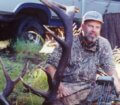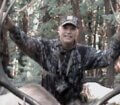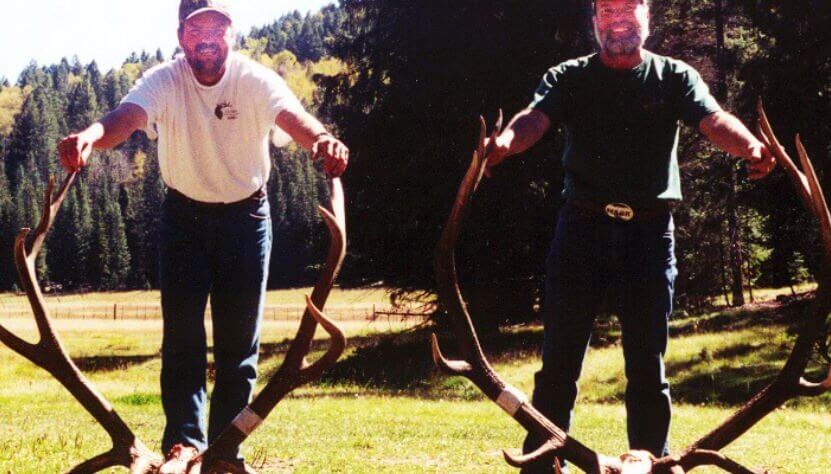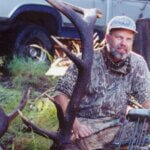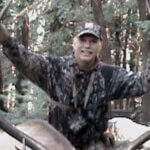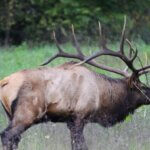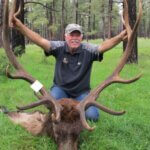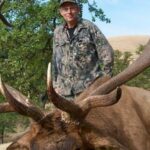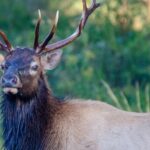Editor’s Note: Mark Hanson, from Mesa, Arizona, has a severe case of elk addiction. Mark took his first bull in 1984 with a bow—a spike with brow tines (a legal bull)—that really hooked him on elk hunting. Since then, he’s taken many bulls with his bow and two in Colorado with a rifle. However, he’s called in numerous bulls for friends and family members—about 100+ bulls. When Hanson isn’t hunting bull elk to take for himself, he hunts with friends and relatives yearly to help record their hunts, find bulls for them, call bull elk, and carry out the meat.
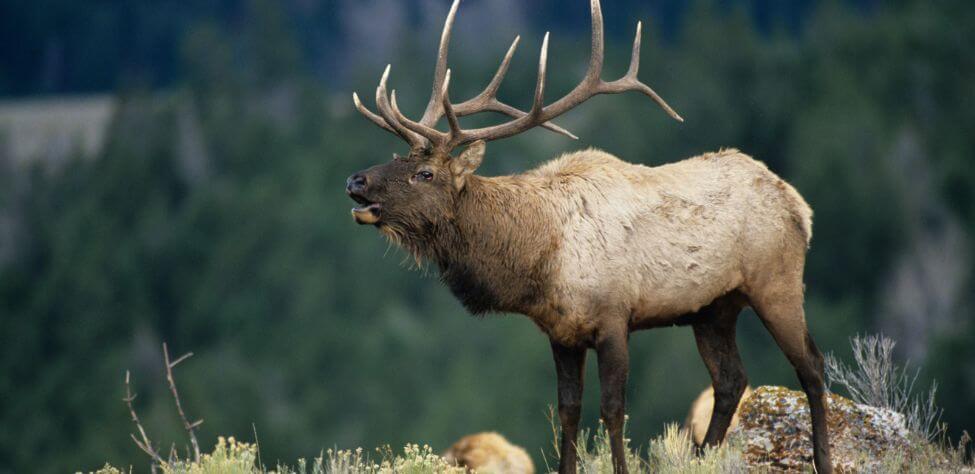
I took a bull elk in 1999 that grossed 368 inches, but he only netted 160 inches. On this hunt, I took my son, Paul, with me. We had our bows, and we planned to scout for elk. However, because deer season was in, if we saw a nice mule deer or a white-tailed buck, we could take him with our bows. We had gotten into camp reasonably late, so we slept in and didn’t get up until just before daylight. Then, we heard an elk bugling in a meadow a few ways above our camp.
Not too far from where we set up our camp, there was an older gentleman and his wife cutting firewood from the dead trees in the forest. So, while it was still dark, we hiked up to the meadow and spotted a giant bull there with his harem of cows. From earlier hunts, I knew elk would feed in the meadows at night and return to the wilderness area just before sunrise. We got up on top of a ridge that was above the trail the elk were using to go back and forth from the meadow to their bedding site in the wilderness area.

Using our binoculars, we saw a cow on the trail first. Next, we heard a ruckus, looked about 60 yards down the trail, and spotted a giant bull raking a tree with his antlers. We continued to watch him as he went to war with that tree. I counted his antlers and knew that he was a 6×7. As I studied the bull’s antlers, I thought he would score about 350 inches. But I believed that if I got any closer to him, I’d risk spooking him out of this area.
Then, I determined which trail the elk used when we left the meadow. I thought if I got ahead of them on Saturday, I might be able to get to a place and set up close enough to the trail to get a shot at the herd bull. I knew on this first day that I had not only found a bull I wanted to take, but I’d also patterned him so well and not spooked him that I should be able to find a place to hunt where he couldn’t see or smell me. I planned to take him on Saturday morning.
Elk season for archery would open on Friday of the following week. I was hunting by myself Friday morning, but one of my other sons came to camp on Friday night to hunt with me. I got up early and went to the trail where I knew this bull and his cows were traveling. But I never could get him to come cow-calling because he had a relatively large harem of cows.
Every time he passed me on that trail, I’d make a big circle around him, try to get in front of the herd, and call him to me. Finally, the herd moved off into a deep canyon and were far enough away from me that I couldn’t hear them.
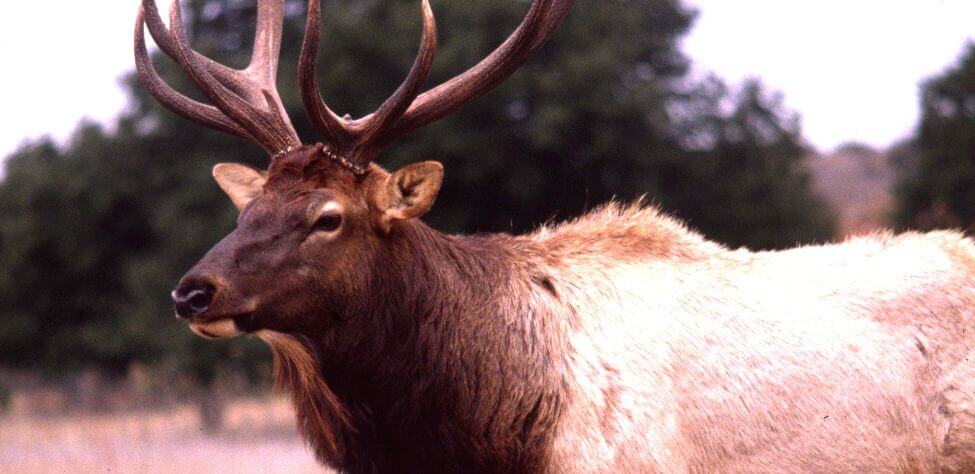
I decided to return to camp and return to the trail late on Friday afternoon, when the elk would be moving from their bedding area and out into the meadow to feed. I started cowcalling a little before dark, and a monster bull appeared. Right at dark, this bull stepped out and presented a shot. I thought the bull was about 45 yards away on the opposite side of the canyon from me, but the light was getting so dim that I misjudged the distance.
By this time, I was already at full draw and had released the arrow. I saw the bull spook and run off. When I went to the spot where I’d taken the shot and found my arrow, it had no blood on it. However, one elk hair was stuck on the blade of my broadhead. I had misjudged the distance and shot over his back. However, the bull had come in so quickly that I knew if I hadn’t taken the shot, I wouldn’t have had a shot. I didn’t have time to range him. So, I returned to camp.
Expert Guidebooks on Elk Hunting: Best Sellers
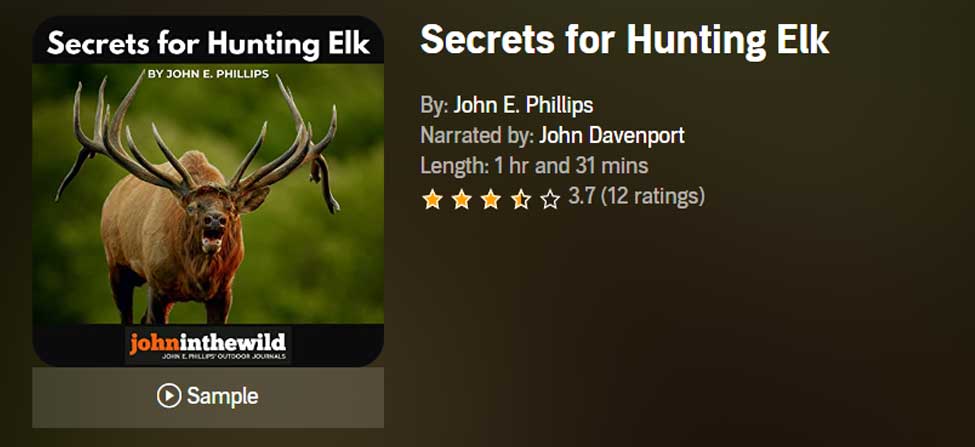
Secrets for Hunting Elk
The quickest, easiest (if there is an easy way), and safest way to find and take that bull elk of a lifetime will be to hunt with a guide.
Chad Schearer, a longtime Montana guide and TV personality, told me, “My hunter is my gun. If I get to the elk, and my hunter isn’t with me, then we don’t take the elk. My job is not only to find the elk but also to help the hunter get to the elk and make the experience as enjoyable as I can for him.” That’s the kind of fella with whom I want to go elk hunting.
An elk hunt can be tough, but it doesn’t have to be so tough that you don’t enjoy it. That’s why this elk hunting book starts with the confessions of an elk guide and with Chad Schearer’s philosophy of what the guide and the hunter’s relationship should be.
A good portion of your success will depend on your physical condition, and Matt Morrett of Harrisburg, Pennsylvania explains how an eastern hunter can get ready physically during June and July to hunt western elk, the animals he describes as, “Like deer or turkeys on steroids.”
Wayne Carlton, well-known elk hunter and TV and video personality from Montrose, Colorado, tells us what types of elk calls to use and what to say to the elk. Mike Miller of Colorado, another elk guide and Mossy Oak video personality, has tactics for the best equipment for bowhunting and gun hunting elk.
You’ll learn helpful strategies and hunting tips in this book, as well as some straightforward hunting methods that will help to make your elk hunt more successful.
“Thanks to the advice in your elk hunting books, I was able to call up a nice 6-point (6X6) bull elk! He was bugling like crazy. I called him in from about a ¼ mile away. Called him into bow range (about 40 yards away). It was a thrill!” ~Rob Brannon
VERSIONS: AUDIBLE & KINDLE
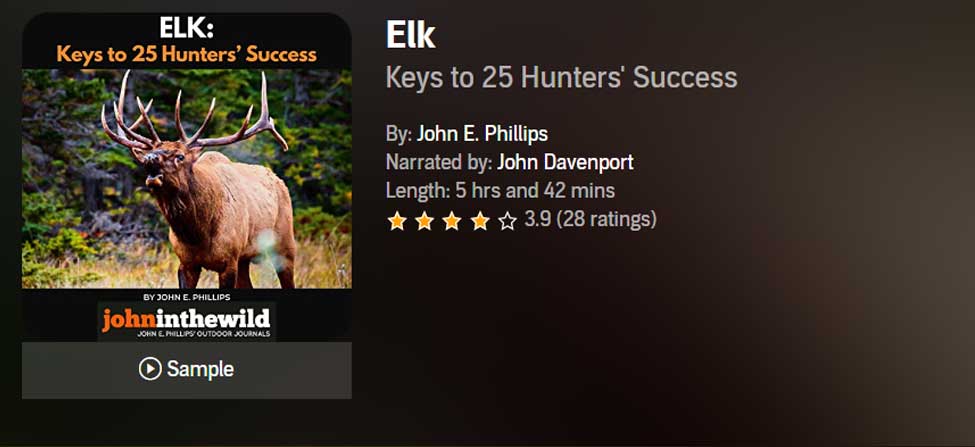
Elk: Keys to 25 Hunters’ Success
Often just one tip or tactic makes the difference in whether you take an elk home to dinner or have to hike back to the truck by yourself. In John E. Phillips’ latest elk book, Elk: Keys to 25 Hunters’ Success, you’ll learn from successful elk hunters the strategies they use to find and take elk.
Many know that the technique that seems to work most often is to hunt where other elk hunters don’t and understand where the elk are before you go on a hunt by studying data from each state, visiting HuntData (see chapter 1), examining maps, and reading postings on elk forums.
This book also tells you how to get ready physically for an elk hunt, including participating in Train to Hunt Competitions, what gear you need to take, how to enjoy a successful do-it-yourself elk hunt, or how to pick the best elk guide for you. You’ll also hear about the X System and the Broken Y System of hunting elk.
Although no one person has all the answers on how to help you find and take your elk, I’m convinced that this book’s outdoors men and women will teach you how to have satisfying elk hunts.
As my friend Karl Badger once told me, “Elk hunting doesn’t get any better than when I ride horses into the high backcountry, see two grizzly bears, hear a pack of wolves howl close to camp all night long, eat plenty of delicious food prepared on a fire and enjoy the company of good friends.”
VERSIONS: AUDIBLE, KINDLE & PRINT
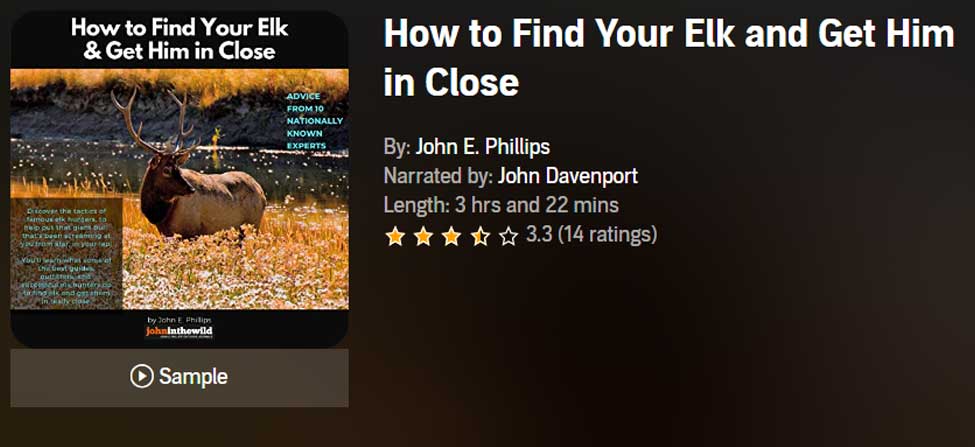
How to Find Your Elk and Get Him in Close will teach you the tactics of 10 nationally known elk hunters, to help put that giant bull that’s been screaming at you from afar, in your lap. You’ll learn what some of the best guides, outfitters, and successful elk hunters do to find elk and get them in really close.
Also in this audiobook, you’ll notice that the majority of the experts call elk to within bow range. We selected numerous bowhunters and bowhunting guides, since the bowhunter has to get much closer to a bull than the gun hunter does – often less than 20 or 30 yards – practically in your lap.
On one elk hunt, I’d heard this bull bugle all morning. My guide had called him within 30 yards, and he was standing just inside black timber. I saw the smoke from his nose wafting out into the icy air less than 30-yards away. All the bull had to do was step out, and I could take the shot with my bow. But then, through no fault of my guide or me, the bull vanished.
The only conclusion I could come up with to understand why the bull I wanted to take with my bow hadn’t stepped out and given me a shot, was because he got raptured. He evidently had left the earth with no trace of himself.
This hunt was when I started wanting to learn more about hunting elk up close. In this book, I’ve tried to find some of the most knowledgeable, experienced, and practical elk hunters. I’ve always found that the best way to learn any outdoor skill, is to either hunt or fish with the best sportsmen in that field.
Often, in elk hunting, that means elk guides, who generally hunt every day of the season and receive a salary for every hunter they guide. So, I’ve put together a group of some of the best elk hunters I know to help us all learn how to find bull elk and get them in close.
VERSIONS: AUDIBLE, KINDLE & PRINT
Tomorrow: Learning More about Big Bow Elk

